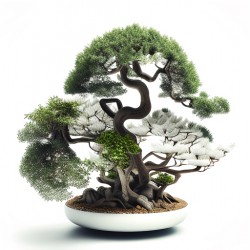Your shopping cart is empty!
MENU

Bonsai is an ancient art form that dates back centuries. It involves the careful shaping of trees and other plants into aesthetically pleasing miniature versions of their natural counterparts. Bonsai enthusiasts take great pride in the creation of these delicate works of art, and it can take years of practice to master the craft.
At its core, bonsai is a connection between nature and mankind. It involves the careful shaping of a tree or other plant over time with careful pruning and wiring techniques. This is done to create a small, aesthetically pleasing version of a tree in its natural environment. The idea behind bonsai is to combine the beauty of nature with the creativity of the artist.
The practice of bonsai involves many different techniques. For example, bonsai specialists utilize pruning techniques such as removing branches to make the tree appear more balanced and symmetrical. They also use wiring techniques to give trees a specific shape or to create a desired look. The wiring techniques can also be used to train a tree to grow in a certain direction or to give it a particular look.
In addition to the physical aspects of bonsai, many enthusiasts also enjoy the spiritual connection they have with their plants. For them, the practice of bonsai is a meditative experience. They find that spending time with their plants can be deeply relaxing and calming. This can also be a great way to connect with nature in a meaningful way.
Many people also enjoy the social aspect of bonsai. There are a variety of clubs and organizations that bring together bonsai enthusiasts from all over the world. These gatherings are great for networking, exchanging ideas, and learning new techniques.
At the end of the day, bonsai is a hobby that allows people to express themselves creatively and to bring a little bit of nature into their lives. It also provides a great way to relax and de-stress. Whether you’re a beginner or an experienced bonsai specialist, there is something for everyone in bonsai.